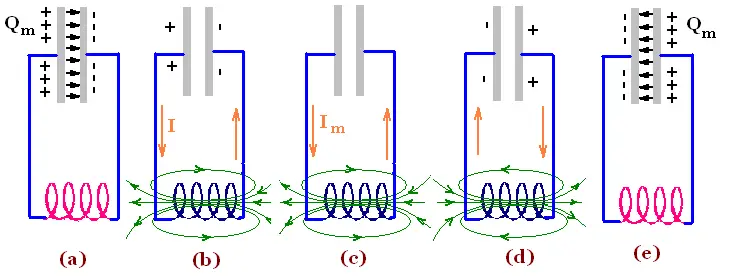|
Electrostatics
Electromagnetics
Electricity &
Magnetism
© The scientific sentence. 2010
|
Electromagnetic oscillations LC and RLC circuits
Capacitors and inductors are energy-storage devices. A capacitor
stores electric energy and an inductor stores magnetic energy.
Resistors just cause energy to be dissipated as a heat.
1. LC circuit: Oscillations
we examine the behavior of an idealized circuit (negligible
resistance), which contains only an inductance L and a
capacitance C, an LC circuit.

The capacitor in the circuit is charged by an
external battery and then the battery is taken away.
When the switch is closed (position 1), the capacitor will
begin to discharge through the inductor.
During the discharging, there is a current I(t) crossing the
circuit and charge Q(t) on the plates of the capacitor.
The current I is the rate at which charge is transferred from
a plate to the other. In the figure, the sense of the current
(positive) is counterclockwise. The potential difference
between the plates is positive. The potential through the
inductor decreases then the difference between the terminals
of the inductor is negative.
Kirchhoff's loop rule gives:
(Vb - Vc) + (Va - Vb) +
(Vc - Va) = 0
.
That is
+ Q/C - L (dI/dt) + 0 = 0 (Eq. 1)
We have I = ± dQ/dt
During the discharging of the capacitor, Q decreases,
hence dQ is negative so is I = dQ/dt and d(dQ/dt)/dt =
d2Q/dt2.
Therefore
I = - dQ/dt. The equation (Eq. 1) becomes:
Q/C + L d2Q/dt2 = 0
.
Rearranging, we find
d2Q/dt2 + (1/LC)Q = 0
Equation of LC oscillation circuit:
d2Q/dt2 + (1/LC)Q = 0
This differential equation is the same as the
differential equation of a simple harmonc oscillator,
like the mass-spring without friction system. The mass-spring
harmonic oscillator provides a mechanical analog to the LC circuit
The solution of this equation is of the form:
Q(t) = Qm cos (ωot + φ)
Where
ωo=[(1/LC)]1/2, is
the angular frequency of the oscillation, φ is the phase constant,
and (ωot + φ) is the phase.
The current is
I = dQ/dt = - Im sin (ωot + φ)
With Im = Qmωo the maximum current.
LC oscillation circuit:
ωo = [(1/LC)]1/2, Im = Qmωo
Q(t) = Qm cos (ωot + φ)
I(t) = - Im sin (ωot + φ)
These two equations describe the oscillation of the
charge and the current, with the frequency νo =
ωo/2π.
The constants Qm and φ are determined from
the initial conditions. Suppose the capacitor was given a charge
Qo while the switch was open, and the switch was closed
at t = 0. Then the initial conditions are Q = Qo, and I = 0
at t = 0.
Substituting I = 0 andwith t = 0 into the above equations, we find:
Q(0) = Qo = Qm cos φ
0 = - Im sin φ
Hence φ = 0 and Qo = Qm. With
Im = Qoωo ,
The equations becomes
Q(t) = Qo cos (ωot)
I(t) = - Im sin (ωot)
2. Energy of LC circuit
The electric energy stored in a charged capacitor is
UE = (1/C) Q2, and the magnetic energy
stored in a current-carrying inductor is UB =
(1/2) L I2. The electromagnetic energy U in
the LC circuit is U = UE + UB.
At time t,
Q(t) = Qm cos (ωot + φ) , and
I (t) = - Im sin (ωot + φ)
Therefore
U = UE + UB =
(1/2)Q2/C + (1/2) L I2
We have
(1/C) Q2 = (1/C) Qm2
cos2 (ωot + φ) , and
L I2 = L Im2
sin2 ωot + φ)
Since
Im = Qmωo,
and ωo2 = 1/LC, we can
write
L Im2 = L Qm2ωo2 =
(1/C) Qm2
Therefore
U = (1/2)Q2/C + (1/2) L I2 =
(1/2C) Qm2 cos2(ωot + φ)
+ (1/2C) Qm2 sin2 ωot + φ) =
(1/2C) Qm2[cos2(ωot + φ)
+ sin2 ωot + φ] = (1/2C) Qm2
= (L/2) Im2
Electromagnetic energy in LC circuit:
U = UE + UB =
(1/2C) Qm2
= (L/2) Im2
The electromagnetic energy in the LC circuit remains
constant. Continually changing back and foorth between
electric energy in the capacitor and the magnetic energy
in the inductor.

|
|